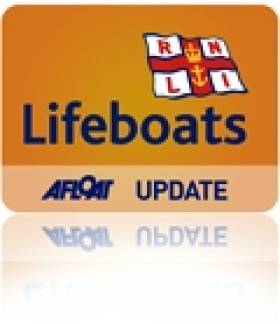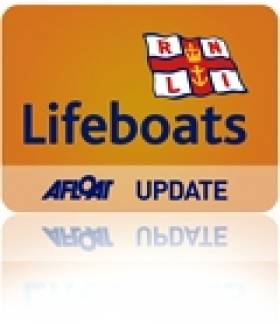Displaying items by tag: Awards
Waterways Ireland Keeps Eye on Prize at Erne Head
#Rowing: Waterways Ireland presented prizes to winning crews after the successful Erne Head of the River on Saturday in Enniskillen. Trinity were the best overall club at the event, while local club Enniskillen Royal Boat Club had the top junior women’s and junior men’s eights.
The chief executive of Waterways Ireland, Dawn Livingstone, said: “I am delighted to support the Erne Head of The River through the Waterways Ireland Event Programme. Sport and recreation on and along the waterways is growing strongly – 30 extra crews came to the event today. We hope to continue to work with Rowing Ireland to see that growth replicated across the waterways through 2017 and into the future.”
The Waterways Ireland head office is sited in Enniskillen.
#Awards - Minister for Transport, Tourism and Sport Shane Ross presented the National Marine Gallantry and Meritorious Service Awards 2016 at a ceremony in Farmleigh House on Friday evening (14 October)
Minister Ross praised the “courageous achievements and service of this group of brave Irish men and women who have faced crises and dug deep, offering their skills and in many cases placing themselves in danger in order that others might be safe on our waterways.”
Pausing to remember those who lost their lives at sea since the previous awards in 2014, Minister Ross spoke of the tragic death of Irish Coast Guard volunteer Caitríona Lucas last month, describing her as “a courageous and heroic woman who made the ultimate sacrifice while in the service of others.”
Among this year’s recipients was Davitt Walsh, who in March rescued a four-month-old baby from the car that slipped into the water from Buncrana pier, claiming the lives of five members of the same family.
The 2016 award recipients are as follows:
- Davitt Walsh – Michael Heffernan Gold Medal for Marine Gallantry
- Gary Robertson – Michael Heffernan Gold Medal for Marine Gallantry
- Skerries Coast Guard Unit – Marine Ministerial Letter of Appreciation for Meritorious Service
- Dean Coleman – Marine Ministerial Letter of Appreciation for Meritorious Service
- Gavin Byrne – Marine Ministerial Letter of Appreciation for Meritorious Service
- Brian Kehoe, Ruairí Nunn, Sam Nunn and Niall McGee – Michael Heffernan Bronze Medal for Marine Gallantry
- The crew of Castletownbere RNLI – Marine Ministerial Letter of Appreciation for Meritorious Service
- Charlie Hennigar – Michael Heffernan Bronze Medal for Marine Gallantry
- The crew of Rescue 116, Dublin Airport – Marine Ministerial Letter of Appreciation for Meritorious Service
- Richard Desay – Marine Meritorious Service Medal
- The officers and crew of Lough Swilly RNLI – Marine Ministerial Letter of Appreciation for Meritorious Service
- Dean Tracey and Paul Dolan – Michael Heffernan Bronze Medal for Marine Gallantry
- The crew of Kinsale RNLI – Marine Ministerial Letter of Appreciation for Meritorious Service
The awards are to recognise outstanding acts of courage, heroism, skill and initiative in the context of marine emergency incidents. The scheme also recognises exceptional dedication to duty in the execution of Ireland’s marine emergency response.
The Marine Gallantry award is presented in the form of a medal, called the Michael Heffernan Medal for Marine Gallantry in memory of an individual who lost his life during a marine incident a number of years ago. Three levels of medal may be awarded — gold, silver or bronze — based on the level of gallantry involved. The medal is awarded in gold, silver or bronze.
A second award, Marine Meritorious Service Medal, may be awarded where outstanding meritorious service has been provided to, or within the remit of, the Irish Coast Guard. The person must have demonstrated exceptional dedication to duty, coupled with skill and initiative, in the execution of the service being provided.
A Marine Ministerial Letter of Appreciation may be awarded for meritorious service where outstanding dedication to duty over a career of service can be demonstrated, or for an act of particular meritorious dedication, showing skill and initiative, but which is not of an order for receipt of a Meritorious Service or Marine Gallantry medal.
The National Marine Gallantry and Meritorious Service Awards Committee is chaired by Bryan Dobson of RTÉ. Members of the committee include representatives of the Irish Sailing Association; Irish Water Safety; Irish Harbour Masters Association; Bord Iascaigh Mhara; Department of Transport, Tourism and Sport; as well as other independent members.
The first award ceremony took place in February 1999 and the awards ceremony was last held on 23 October 2014.
Dublin Port Adds Another Award For Winning September
#DublinPort - It's been a proud September for Dublin Port thus far, what with yesterday's announcement that the capital is shortlisted for the seventh ESPO Award, and last week's Allianz Busines to Arts Award for the 'Dublin Ships' installation.
The Dublin Port Company can add an 'Excellence in the Community' garland to that collection, after recogition by the Chambers Ireland Corporate Social Repsonsibility Awards last Thursday 3 September.
As the official Dublin Port Company blog reports, the award is for the port's sponsorship of the IFSC-based National College of Ireland's Early Learning Initiative, which aims to assist the educationally disadvantaged through an integrated programme for children, their families and educators from early years through to third level.
Sligo Bay RNLI Celebrates 15th Anniversary This Weekend
#RNLI - Sligo Bay RNLI will celebrate its 15th anniversary this Sunday (16 June) with an open day at the lifeboat station in Rosses Point.
There will be an opportunity to chat to the crew, have a look around the station, visit the lifeboat shop and enjoy the seafaring music provided by the groups involved in the Sea Shanty Festival which is also taking place this weekend from 14-16 June.
Sligo Bay RNLI began life in a prefab cabin at Sligo Yacht Club back in 1998. Construction on the new lifeboat station situated at the pier in Rosses Point was completed in 2002. It houses a D Class lifeboat named Elsinore and has 22 volunteer crew members, along with a fundraising team and a lifeboat shop.
As part of the Sea Shanty Festival there will a gala concert in the Yeats Country Hotel on Saturday night (15 June), all proceeds from which will go the Sligo Bay lifeboat station. Tickets are available from the lifeboat station shop, Bay View Stores, Rosses Point and Source on John St in Sligo.
Elsewhere, RNLI volunteers and supporters from around Ireland were recognised for their role in supporting and raising funds and awareness for the lifesaving charity and its crews at the RNLI Annual Presentation of Awards in the Great Hall at Trinity College Dublin.
Guest of honour was the outgoing chairman of the RNLI, Admiral the Lord Boyce, who handed out awards to 51 volunteers throughout Ireland.
Irish Coast Guard director Chris Reynolds and his wife Geraldine along with Irish Water Safety CEO John Leech were also in attendance at the ceremony, presided over by the chairman of the RNLI Council of Ireland, John Coyle.
Awards presented on the day included two Gold Badges, four Silver Badges, 19 statuettes, 17 Bronze Badges, one pair of RNLI binoculars and eight Supporter Awards.
The Gold Badges were received by Jackie O’Grady from Clifden RNLI branch for his work over 25 years with the station, and to Hugh Stafford in Wexford for his role in the setting up of the Fethard-on-Sea lifeboat station in the early 1990s and his work since then in raising funds for the charity.
Also receiving an RNLI statuette was former lifeboat man at Rosslare Harbour, Fergus Wickham, who was recognised for almost five decades of volunteering with the RNLI, first as a lifeboat man and then as a launching authority at the station.
Minister Praises Ireland's Angling Resource At Specimen Awards
#Angling - The Irish Specimen Fish Committee (ISFC) held its Specimen Fish Awards Day yesterday (Sunday 17 February) in Swords, Co Dublin coinciding with the Ireland Angling Show 2013.
Successful anglers from all over Ireland who caught specimen fish in lakes, rivers or in the sea in 2012 were congratulated by Minister of State for Natural Resources Fergus O’Dowd on their excellent achievements.
Last year was a record one for angling in Ireland, with a total of 640 specimen fish being ratified.
Minister O'Dowd said: “The Government recognises that angling is hugely important to the tourist industry and to the economy generally. Preliminary information from a survey commissioned by IFI estimates that angling tourism spend is €250m million per annum – approximately €150m of which is generated by domestic anglers.
"Angling opportunities in Ireland are among the best in the world and this is reflected in the demand for the product and the numbers engaged in it both at home and from abroad.
"The quality of our angling resource is reflected in the annual report of the Irish Specimen Fish Committee. The committee accepted over 640 claims in 2012 – a record. Irish anglers took over 90% of these fish with visitors from overseas taking the remainder.”
The minster also emphasised the importance of the half-century of information about large fish caught by anglers in Ireland, both freshwater and marine, which has been collected by the ISFC over the years.
This information is not only an important historical and heritage record but also a vital guide for anglers when choosing the best angling venues, dates, times and method to catch large specimens of their favourite species.
Anglers departed the awards event with their certificates and plenty of information to target new species in the new angling season in 2013.
The Specimen Fish Committee (ISFC) report 2013 can be downloaded from www.irish-trophy-fish.com. If you catch a big fish in 2013, log on to the website to see how to register your fish as a specimen.
Four News Records in Irish Specimen Fish Committee's 2011 Report
#ANGLING - The Irish Specimen Fish Committee's annual report for 2011 features catch details for 587 specimen fish as well as four new records, according to The Irish Times.
The report comes ahead of the committee's annual awards event at the Red Cow Moran Hotel in Dublin on Saturday 3 March, recogising those anglers who work hard to catch and record the biggest fish of each of Ireland's species.
Those in line for awards include Terry Jackson, who caught a 2.1kh roach/rudd hybrid in the River Lagan; Dutchman Jan Vrieswijk who landed a 1.33kh blackmouth dogfish in Red Bay, Co Antrim; and Noel Lane for his 2.83kg thin-lipped mullet from Cork Harbour.
The Irish Times has more on the story HERE.
Awards for RNLI Volunteers on Isle of Man
#RNLI - Peel Lifeboat Station is three times proud as a trio of its volunteers will receive awards for their services to the RNLI.
IsleOfMan.com reports that the badge winners were announced at the RNLI headquarters in Poole as part of its 2012 awards list.
Bronze badges will go to Francis Watterson and press officer and past chairman Malcolm Kelly, while Adrienne Teare was awarded a gold badge.
All three will be presented with their badges at a function later this year.
RNLI Peel is one of five lifeboat stations on the Isle of Man servicing much of the Irish Sea between northern England, Scotland and Ireland.

































































